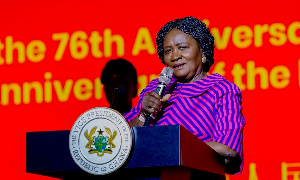Harnessing Remittances For Economic Development: A Case For Remittance Policy In Ghana.
Remittance policy should generate a new interest for Ghanaian policy makers, and politicians, as well as development analysts as remittances by Ghanaians abroad rise to a level that is comparable with its development assistance and foreign direct investments. There are opportunities to improve receipts of foreign currency through remittances from Ghanaians abroad. The country needs a coherent remittance policy to maximize the benefits of remittances in nation building. To achieve this objective, a remittance policy at national level should be part of a broader set of reforms aimed at modernizing the financial system to allow financial institutions to compete successfully with money transfer firms. Besides lowering transfer costs significantly, this policy might also attract additional remittances (money sent home by Ghanaians abroad) currently being transferred through unofficial channels. Remittance policy should also focus on redirecting some of the remittances towards investments, and provide incentives for citizens abroad to contribute towards the development of their communities at home.
The Bank of Ghana reported that Ghanaians abroad sent home an amount of $1.3billion in 2002 (Ghanaweb). This amount nearly matches total revenue from merchandise exports (US$1.94), highlighting the importance of migrants for generating foreign exchange and savings. The true value of remittances is likely to be much higher as only a portion of total remittances passes through official channels. The amount of remittances sent to Ghana by Ghanaians abroad is determined by factors such as personal and family situation back home, total earnings, the amount saved, as well as the number of dependents at home. Other factors are economic activities in the host countries, exchange rates, political risk, marital status, and the level of education of migrants. Studies on remittances to Africa reveal that the higher the education of migrants, the lower the likelihood that they would remit (Lowell, 2001). These studies note that highly educated migrants from Africa including Ghana appear more independent from their relatives back home than the less educated ones. Migrants with high salaries tend to save or invest significant part of their financial resources in their respective host countries.
Until now, however, policy makers, development agencies, economists, and researchers have shown little interest in the role of remittances in economic development, arguing that remittances were used for consumption, and not for productive investment. But this position has changed for two main reasons. First, remittance growth has soared substantially: the World Bank reports that US$111 billion was remitted world wide in 2001--of this amount about 65 percent went to developing countries. Second, organized groups of migrants, known as Hometown Associations (HTAs) have begun to channel a portion of their resources to fund local infrastructure projects.
More recent scholarship on remittances by migrant workers reveals that the traditional view that remittances do not have a positive impact on growth fails to grasp a far more complicated picture. The indirect effects of consumer spending by receiving families and a small but still significant amount of productive investments are seen as important contributors to migrants sending economies. I will argue that remittances have wider multiplier effects on income, employment and production that affect both the migrant and the non-migrant population than recognized by some experts. Furthermore, migrants’ remittances have a significant stimulus to the agricultural and commercial sectors.
Given the importance of remittances in households’ income and in light of the multiplier effects of remittances on production, income and employment, the government of Ghana should have a remittance policy that aims at maximizing the impact of these flows on growth and development. A number of other migrant countries, including India, Pakistan, and Egypt, and more recently, Latin American countries such as El Salvador, Nicaragua, Honduras, and Guatemala already have remittance policies. These countries have devised mechanisms aimed at mobilizing remittances for investment through higher interest rates on term deposits, foreign currency denominated banking accounts, and tax incentives.
Furthermore, institutions have been established in these countries to encourage the repatriation of remittances and complement them with government programs to promote small-scale industries. Training programs for returned migrants and schemes to use seed money for migrants’ start-up businesses are promoted. Also, some countries allow migrant residents abroad to export to their families in the home country machinery, vehicles and capital goods at lower tariff rates.
A coherent remittance policy should selectively target the appropriate groups and give them incentives to use remittances to encourage growth and development in their communities or regions. Some scholars (Siri and Calderon 1996) have grouped remittance policies into three categories. First, policies oriented to increase the flow of remittances and to channel migrants’ savings into national financial institutions. Second, policies to promote savings and investment among the receiving households in the country of origin; and third, policies to promote infrastructure development financed totally or partially by “collective,” remittances.
POLICIES MEANT TO REDUCE TRANSFER COSTS
The first type of policy is directed to migrants themselves. Some of these policies are designed to encourage the participation of social organizations to function as exchange houses to reduce transfer costs. In some cases, there have been attempts to negotiate directly with money transfer firms for a reduction in transfer fees. Another policy instrument used in other countries is the promotion of cooperatives and foreign branches of national banks. One joint effort, known as the International Remittance Network (IRN), allows migrants to deposit remittances in United States and withdraw them in their country of origin. All these policy measures are meant to promote competition among transfer firms to reduce excessive transfer fees. A 1997 study by the Mexican senate estimated that the loss due to excessive charges and exchange rate manipulations by transfer firms was about 20 percent of the total flow of remittances. Western Union settled a suit brought by Mexican organization in United States for failure to disclose the true cost of transfers.POLICIES TO REDIRECT SOME OF THE REMITTANCES TO INVESTMENTS
The second policy measure that attempts to channel remittances to promote development is directed towards households that receive the remittances. These policies encourage the creation of social funds, as well as savings and credit plans to finance home purchases and small business start-ups. Some governments have also sponsored educational programs to change spending habits among households receiving remittances in order to encourage the use of remittances for development projects. Non-governmental organizations have also promoted the productive use of remittances among poor households and have provided technical assistance programs to help migrant households to develop small-scale productive projects. In Philippines, the Philippines based NGO; “UNLAD KABAYAN “ is mobilizing migrant workers resources for productive use and community development. It mobilizes and pools migrant savings together, identifies appropriate investments, and facilitates credit applications with the objective to create jobs through sustainable business. There are three services available to migrants under this program: 1) savings accounts 2) investments in existing businesses and special start-up funds.Also in Indonesia, Micro Banking Division of Bank Rakyat Indonesia (BRI) is capturing remittance transfers and putting them to productive use in rural areas. Besides, saving services, BRI also offers additional financial services, the bank lends to immigrants workers’ families, which could be paid back with remittances sent by the migrant abroad. BRI also offers credit to migrant workers at the time of departure, which is secured with solidarity group.
POLICIES TO INVOLVE MIGRANTS IN THE DEVELOPMENT OF THEIR COMMUNITIES AT HOME
The third type of a remittance policy is directed towards groups of migrants abroad. There has been great interest recently in the development of hometown associations in United States. Migrants from the same place of origin form associations to finance specific project in their hometowns. These funds are earmarked for social projects, such as: the reconstruction of a local church, the renovation of a local clinic or local school, the construction of a library or some other project specified by the community. I was talking with a friend recently who informed me of the Bodomaseman Association in Virginia. This group, I learnt, has financed the construction of a community center and water project in its hometown. There are many of such Ghanaian immigrants’ associations in North America and Europe. The Ghanaian government needs to motivate these associations and help promote the formation of more of such hometown associations. The government can collaborate with these associations in its rural or community development programs as being done in many Latin American countries.In Zacatecas state of Mexico, there is a program called, “Two For One” in which the state government invest $2 in infrastructure projects for each dollar invested by its citizen abroad. In Jaliasco, the state government has established a fund to finance a series of infrastructure projects in migrant-sending regions and it expect to receive matching funds from the World Bank, and the Mexican Financial Bank. During the 1990s, The Mexican government took the initiatives in reaching out to its emigrants in the United States, helping them to form hometown associations (HTAs) and encouraging members to remit and invest in their communities of origin. The HTAs have served as platforms for matching fund schemes that pool remittance money with government funds and expertise, and occasionally with private-sector contributions, for locally focused economic development projects. Mexico realized $9.3 billion from remittances from abroad in 2001 as result of pursuing the foregoing innovative programs, and the trend is to continue at an annual rate of 12.3 percent every year.
The Ghanaian government should initiate a policy to court Ghanaian Hometown Associations and private sectors to channel funds into job-generating projects. This could be done by creating a unit or an agency, for example, “The Migrants Living Abroad Office,” or by presidential visits. Such an office should liaise with multilateral organizations like the World Bank, USAID, CIDA and other international organizations to discuss ways to channel matching funds in order to complement the effect of remittances in rural or community development projects.
VOLUNTARY CHECK-OFF CONTRIBUTION
Another area that can be explored by the Ghanaian government in collaboration with the money transfer companies is the “ Voluntary Check-Off Contribution.” Under this program money transfer companies might offer remitters an option, at the point of sale or transfer, to voluntarily donate a portion of their money to economic development. The form used to transfer the money could contain a box that customers could check off if they wished to donate some part of their remittances to special fund. For example, US$1 contribution could be earmarked for educational reform, or qualifying charitable organizations that work in Ghana. A government or independent private sector NGO could manage these development funds, and the customer might be asked to choose from a range of possible destinations for the donation.THE USE OF FINANCIAL INSTRUMENTS TO ATTRACT REMITTANCES THROUGH OFFICIAL CHANNELS
Remittance Foreign Currency Accounts: Many countries allow migrants to remit their foreign earnings into foreign-currency accounts (RFCAs) in domestic banks that are not subject to foreign exchange regulations. India and Pakistan have an active interest rate policy relating to these accounts in order to ensure an attractive premium over world financial market rates for account holders. In Pakistan, the rate on foreign currency accounts is constantly adjusted in line with the movements in the Eurodollar deposit rates in London. The India government also consistently maintained interest rates on these accounts at substantially higher level than that on comparable domestic or Euro-currency deposit.Bangladesh offers a premium exchange rate conversion of foreign-currency balances into local currency. Migrant workers are also allowed to sell the balances in foreign currency accounts directly to importers through daily “auctions” conducted by the major national banks. The only problem with these policy instruments is that they are attractive to the highly educated, and higher skilled categories who earn relatively higher incomes.
Foreign currency bonds: Some countries like India, Pakistan, and Bangladesh use foreign currency denominated bonds as a tool for stimulating remittances. Foreign currency bonds are similar to repatriable foreign currency accounts in that the money invested is repatriable without being subject to foreign exchange regulations. Several years ago, Mexican banks began offering remittances bonds backed by money sent from migrants abroad in United State (Druckerman 1998). For the most part, banks that receive large amount of wire transfers from workers and companies abroad issue the bonds. Many third world countries like Philippines, Brazil and Turkey are exploring this financing options and new sources of debt marketing. The Ghanaian government should explore the possibility of using these financial instruments to attract more remittances through the official channels.
In conclusion, I would say that the formulation of a coherent remittance policy by Ghanaian government would call for collaboration among Ghanaian Hometown Associations, financial institutions, the government, and the entire Ghanaian community in the diasporas. To be effective, policy options to increase the volume of remittances to Ghana through official channels should have a direct effect on issues relating to reducing transaction costs, leveraging the capital potential through banking, and promoting tourism. There is a need for more innovative ideas to generate more foreign currency from other sources to help extricate the country from the financial and political clutches of the international financial institutions.















